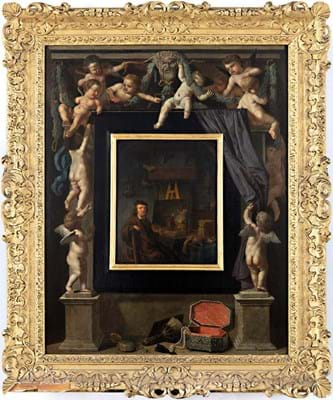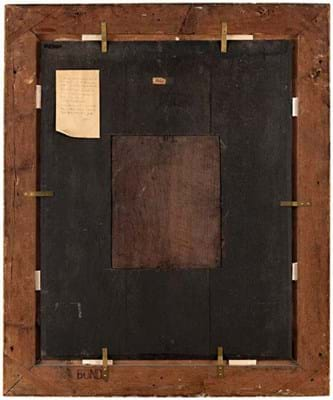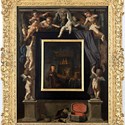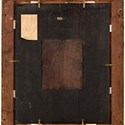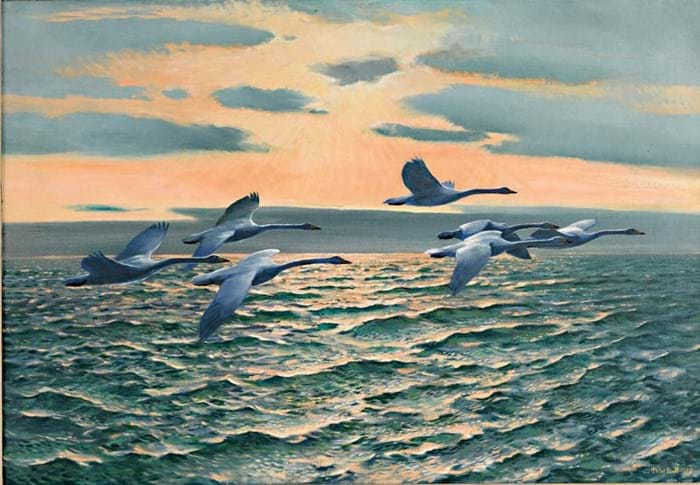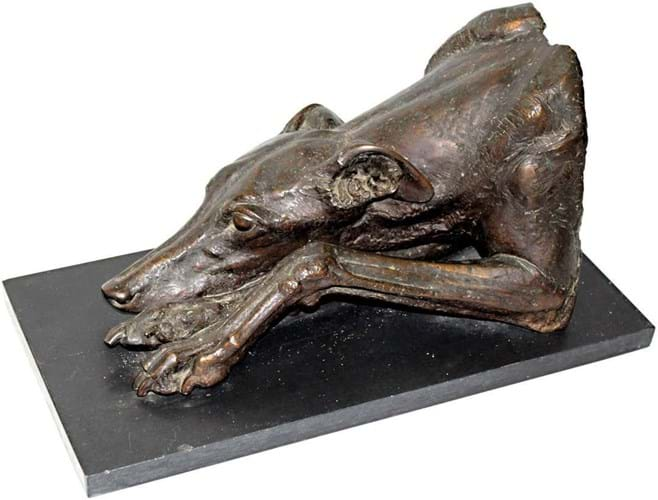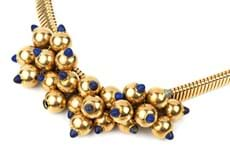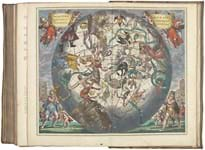The first six-figure price for an Old Master in the English regions of 2022 emerged at Lawrences (25% buyer’s premium) of Crewkerne when a curious combination of panel paintings by two 17th century Dutch artists came to the auction block.
Comprising two separate works fitted together, the lot offered on January 19 featured an intriguing central element and an elaborate border section.
The former was a self-portrait by Jacob Van Spreeuwen (c.1611-65) showing the artist painting one of his known works: St Jerome in the Wilderness. Believed to date from c.1650, it was housed within a slightly later and ornately decorated surround painted by the Delft artist Cornelis De Man (1621-1706). Together the two panels measured 2ft 8in x 2ft 2in (83 x 65cm).
The ‘frame’ part of the ensemble was believed to have been created c.1665-80 and was probably originally conceived to contain a mirror.
However, for reasons unknown, Van Spreeuwen’s 13¾ x 11in (35 x 28cm) oil on panel had been placed within it at some point in the past instead – perhaps simply to make it more eye-catching as a conjoined piece.
The vignettes depicted on De Man’s border section certainly gave the combined work strong appeal both artistically and for the added wall-power. They featured 10 cherubs around a stone recess with facing plinths, surmounted by a mask of the devil. Attractive details included the ‘trompe l’oeil’ elements such as the putti drawing back the curtain as well as the ‘vanitas’ emblems adorning the lower section – the casket of jewellery, pearls and powder brush all alluding to a lady’s dressing table.
The plinth to the lower right had the signature CMan f F and an indistinct date. Dutch and Flemish paintings specialist Dr Fred Meijer, who assisted Lawrences with the cataloguing, suggested that De Man’s painting was almost certainly a specific commission – the fact that stylised frames such as this are almost unheard of in his oeuvre and that putti rarely feature in his work in any case would seem to support this.
One similar example is known, however: a picture that was formerly with Zurich dealer Bruno Meissner back in the 1980s and which may well be its pair.
Works by De Man and Van Spreeuwen do not appear on the open market with any regularity. Of the two, De Man probably has the higher commercial reputation.
While Van Spreeuwen was a Leiden artist closely associated with Gerrit Dou (1613-75), his pictures that have emerged at auction tend to be fairly dark interiors typically realising fourfigure sums rather than five figures.
De Man was part of the group of genre painters from Delft who specialised in scenes of bourgeois families in the manner of Jan Vermeer and Pieter de Hooch. He also painted a series of portraits, church interiors and some Italianate landscapes, although rarely in a style as flamboyant as this ‘frame’.
His works can easily sell for five figures and occasionally make six figures, such as his portrait of the pharmacist Dr Strand Ysbrandsz that made €144,000 (£124,140) at Sotheby’s Amsterdam in November 2006 – a work now in the Leiden Collection (the private group of Old Masters formed by American investor and asset manager Thomas S Kaplan and his wife Daphne).
Grange provenance
Lawrences’ picture came to auction having been kept (‘since time immemorial’ according to the auction house) at Creech Grange in Dorset, the property of the historic Bond family. In 1931 it was photographed for Country Life magazine hanging in the drawing room.
Having been removed from the mansion near Wareham when the property was sold in 1975, it had since been on loan at the Dorset County Museum.
Both panels were in decent original condition with only a little cosmetic restoration (mainly carried out when on loan to the museum). The Van Spreeuwen required the removal of some discoloured varnish but promised to clean very well indeed.
Such an unusual work was tricky to estimate. The auction house eventually settled on a £10,000- 15,000 pitch, although Lawrences picture specialist Richard Kay noted that the combination of provenance, rarity, good condition and it being “eye-catchingly unusual” made it a potentially much more valuable proposition.
And so it proved. Enquiries came from both the UK and abroad after the catalogue went live and on the day a prolonged bidding battle came down to a couple of phone bidders.
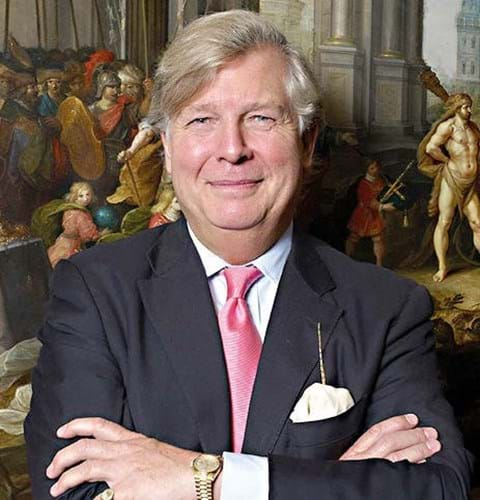
Art dealer Johnny Van Haeften.
It was sold at £125,000 to Johnny Van Haeften who saw off strong underbidding from an institution. According to Kay, the London dealer remained “impressively stoic and calm” when his competitor’s phone line went awry for around two minutes as the competition progressed.
Although the price is difficult to compare to other paintings given the nature of the work, it certainly looks impressive given that only a small number of pictures by De Man have ever made more at auction while no work by Van Spreeuwen has even come close.
Van Haeften told ATG: “I think what struck me about it was the highly unusual format, the great condition, and I always love trompe l’oeil! Both parts are equally interesting… It’s impossible to tell when they were joined, but I guess no later than the 19th century. The object is definitely a ‘marriage’ in furniture parlance.”
Whether the two pictures will continue to hold this close embrace remains to be seen, however. “I think it might make more sense to separate them, as long as the sum of the parts is worth more than the whole”, said Van Haeften. “The fact that they’re from different cultural bases supports that, and I don’t think they really work very well as an ensemble. They weren’t born like this and I’d like to see an old mirror in the De Man.”
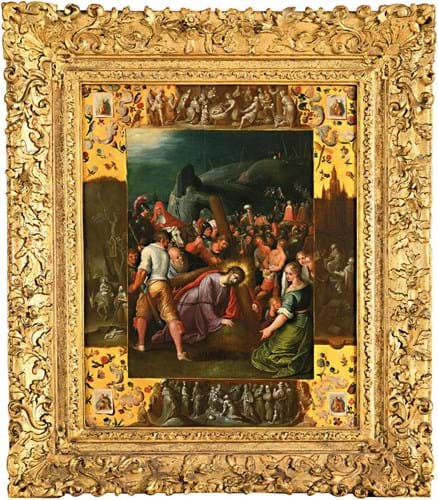
'The Road to Calvary', a work catalogued as ‘attributed to Frans Francken the Younger’ – £5000 at Lawrences.
The dealer was active elsewhere in the sale. A scene of Christ falling on the road to Calvary, which came from the same source and had also been on loan to Dorset County Museum, was ‘attributed to Frans Francken the Younger (1581-1642)’.
While the Calvary theme was a frequent subject for the Francken family of artists, again this oil on panel had an unusual painted border with decorative motifs – this time showing details of biblical scenes as well as floral and animal patterns on a gilt ground to each corner.
Measuring 21 x 16¾in (53 x 42cm) overall, it had a few more condition issues including some retouching along a vertical split running near the centre of the panel which had been repaired. Pitched at £5000-7000, this time it commanded less interest but sold to Van Haeften on low estimate.
“Again the border was what attracted me”, said Van Haeften. “The border is actually of better quality than the main picture and these are clearly two hands. I don’t believe the central theme is by Frans Francken the Younger, but one of his pupils or family, most likely Hieronymous Francken; we need to do some research. But I don’t rule out Frans having painted the borders, as they’re such excellent quality. Time will tell.”
Portrait opportunities
The bumper crop of Old Masters in the Lawrences sale included a number of portraits of historical figures, although some met with a mixed performance. One success was a portrait of Peter the Great, tsar of Russia (1672-1725), catalogued as ‘circle of Carel de Moor’ (1655-1738)’. The Dutch artist is known to have received commissions from the tsar and his second wife Catherine I and a portrait of Peter, painted in a different format to this picture, is now in the Hermitage collection in St Petersburg.
The 2ft 4in x 2ft (72 x 62cm) oil on canvas here showed the sitter in colourful but less formal attire. Consigned from a deceased estate in Wiltshire with its earlier history unknown, it was estimated at £4000-6000 but proved intriguing enough to bring £8000, selling to the Belgian trade.
In terms of the modern pictures in Crewkerne, a decent battle came for an atmospheric 1958 oil painting of whooper swans in flight by Sir Peter Markham Scott (1909-89). Emerging from a deceased estate in Somerset, it had been purchased from London dealership Ackermann not long after it was painted.
Kay said the signed 2ft 1in x 2ft 11in (63 x 90cm) oil on canvas was “much admired for its scale, quality, fine condition, the pleasing coral tones of the sky… and a feeling of breeze upon the water”.
Of the numerous paintings of birds in flight by the naturalist painter, examples depicting swans are particularly popular and those vividly painted close-up views of their subjects tend to make the higher prices. This example also benefited from its good condition.
Pitched at £4000-6000, it sold at £12,000 to a private collector in London who outbid both the trade and other private bidders. The price was the third highest for the artist at auction in the last 10 years (source: Artprice).
Greyhound study
Another animal-themed lot doing well, this time a sculpture, was a 1950s lifesize head study of a greyhound by Sally Arnup (1930-2015).
The 9in (23cm) high bronze came to auction from a descendant of her tutor at the Royal College of Art, John Skeaping. In his 1977 autobiography, Drawn from Life, Skeaping wrote of Arnup that she “was a one-time pupil of mine and probably the best animalier of today”. She later became head of sculpture at York School of Art from 1958-72 but her earlier work in particular remains admired for its realism and immediacy (she often created her works directly from life).
The bronze here was from an edition of 10 and was estimated at £2000-3000. It sold at £4200, equalling her auction record alongside Lioness Walking, also from an edition of 10, that fetched the same sum at Tennants in March 2019.
Another Arnup bronze from the same source, again with a greyhound subject and from an edition of 10, took £3600 against a £800-1200 estimate at Lawrences. As well as registering strong sums, the fact that both lots sold to different private collectors suggested an increasing depth of interest in Arnup’s work.
With Lawrences raising an overall total of nearly £1.6m from its four auctions across the week, the saleroom reported a willingness from buyers to spend money in January despite it often being considered one of the quieter months. For followers of Old Masters, it was encouraging to see the sector making a useful contribution to these results.


